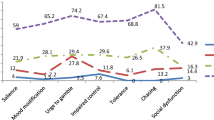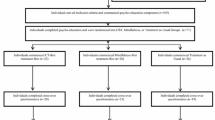Abstract
It has been estimated that 80% of Australians engage in some form of gambling, with approximately 115,000 Australians experiencing severe problems (Productivity Commission 2010). Very few people with problem gambling seek help and, of those who do, large numbers drop-out of therapy before completing their program. To gain insights into these problems, participants who had either completed or withdrawn prematurely from an individual CBT-based problem gambling treatment program were interviewed to examine factors predictive of premature withdrawal from therapy as well as people’s ‘readiness’ for change. The results indicated that there might be some early indicators of risk for early withdrawal. These included: gambling for pleasure or social interaction; non-compliance with homework tasks; gambling as a strategy to avoid personal issues or dysphoric mood; high levels of guilt and shame; and a lack of readiness for change. The study further showed that application of the term ‘drop-out’ to some clients may be an unnecessarily negative label in that a number appear to have been able to reduce their gambling urges even after a short exposure to therapy.
Similar content being viewed by others
References
Abbott, M. W., & Volberg, R. A. (2000). A report on phase one of the 1999 national prevalence survey: Taking the pulse on gambling and problem gambling in New Zealand. Wellington: Department of Internal Affairs.
Abbott, M. W., Williams, M., & Volberg, R. (1999). Seven years on: A follow-up study of frequent and problem gamblers living in the community. Report no. 2 of the New Zealand gambling survey. Wellington: Department of Internal Affairs.
American Psychiatric Association. (2000). Diagnostic and statistical manual of the mental disorders (text revision) (4th ed.). Washington, DC: American Psychiatric Association.
Anderson, G., & Brown, R. I. F. (1984). Real and laboratory gambling, sensation seeking and arousal: Toward a pavlovian component in general theories of gambling and gambling addiction. British Journal of Psychology, 75, 401–411.
Bados, A., Balaguer, G., & Salaña, C. (2007). The efficacy of cognitive-behavioral therapy and the problem of drop-out. Journal of Clinical Psychology, 63, 585–592.
Blaszczynski, A. (1998). Overcoming compulsive gambling: A self-help guide using cognitive behavioural techniques. London: Robinson Publishing.
Blaszczynski, A. (2005). Conceptual and methodological issues in treatment outcome research. Journal of Gambling Studies, 21, 5–11.
Blaszczynski, A., Drobny, J., & Steel, Z. (2005). Home-based imaginal desensitization in pathological gambling: Short-term outcomes. Behavior Change, 22, 13–21.
Blaszczynski, A., & Nower, L. (2002). A pathways model of problem and pathological gambling. Addiction, 97, 487–499.
Blaszczynski, A., Steel, Z., & McConaghy, N. (1997). Impulsivity in pathological gambling: The antisocial impulsivist. Addictions, 92, 75–87.
Bowling, A. (1999). Research methods in health: Investigating health and health services. Philadelphia: Open University Press.
Britten, N. (2006). Qualitative interviews. In C. Pope & N. Mays (Eds.), Qualitative research in health care (3rd ed., pp. 12–20). Carlton, VIC: Blackwell Publishing Ltd.
Cox, B. J., Yu, N., Afifi, T. O., & Ladouceur, R. (2005). A national survey of gambling problems in Canada. Canadian Journal of Psychiatry, 50, 213–217.
Czerny, E., Koenig, S., & Turner, N. E. (2008). Exploring the mind of the gambler: Psychological aspects of gambling and problem gambling. In M. Zangeneh, A. Blaszczynski, & N. E. Turner (Eds.), In the pursuit of winning: Problem gambling theory, research and treatment (pp. 65–82). New York: Springer Science and Business Media.
De Jong, K., Moerbeek, M., & van der Leeden, R. (2010). A priori power analysis in longitudinal three-level multilevel models: An example with therapist effects. Psychotherapy Research, 20, 273–284.
Delfabbro, P. H. (2008). Australasian gambling review (AGR) fourth edition (1992–2008). Adelaide: University of Adelaide.
Dowling, N., Jackson, A. C., & Thomas, S. A. (2008). Behavioural interventions in the treatment of pathological gambling: A review of activity scheduling and desensitization. International Journal of Behavioral Consultation and Therapy, 4, 172–187.
Dowling, N., Smith, D., & Thomas, T. (2009). A preliminary investigation of abstinence and controlled gambling as self-selected goals of treatment for female pathological gambling. Journal of Gambling Studies, 25, 201–214.
Dunn, H., Morrison, A. P., & Bentall, R. P. (2006). The relationship between patient suitability, therapeutic alliance, homework compliance and outcome in cognitive therapy for psychosis. Clinical Psychology and Psychotherapy, 13, 45–152.
Echeburúa, E., Báez, C., & Fernández-Montalvo, J. (1996). Comparative effectiveness of three therapeutic modalities in the psychological treatment of pathological gambling: Long-term outcome. Behavioral and Cognitive Psychotherapy, 24, 51–72.
Echeburúa, E., & Fernández-Montalvo, J. (2005). Psychological treatment of slot-machine pathological gambling: New perspectives. Journal of Gambling Studies, 21, 21–26.
Evans, L., & Delfabbro, P. H. (2005). Motivators for change and barriers to help-seeking in Australian problem gamblers. Journal of Gambling Studies, 21, 133–155.
Fukushima, H., & Hiraki, K. (2009). Whose loss is it? Human electrophysiological correlates of non-self reward processing. Social Neuroscience, 4, 261–275.
Grall-Bronnec, M., Wainstein, L., Guillou-Landréat, M., & Vénisse, J. (2009). Pathological gambling among seniors. Alcoologie et Addictologie, 31, 51–56.
Green, J., & Thorogood, N. (2009). Qualitative methods for health research (2nd ed.). London: SAGE Publications Ltd.
Grimard, G., & Ladouceur, R. (2004). Intervention favoring control of gambling urge in players at risk of pathalogical gambling. Journal de Thérapie Comportementale et Cognitive, 14, 8–14.
Haworth, B. (2005). Longitudinal gambling study. In G.Coman (Ed.), Proceedings of the 15th annual conference of the national association for gambling studies (pp. 128–154), Alice Springs.
Helbig, S., & Fehm, L. (2004). Problems with homework in CBT: Rare exception or rather frequent? Behavioural and Cognitive Psychotherapy, 32, 29–301.
Hodgins, D. C., & El-Guebaly, N. (2000). Natural and treatment-assisted recovery from gambling problems: A comparison of resolved and active gamblers. Addiction, 95, 777–789.
Jackson, A. C., Thomas, S. A., Thomason, N., Borrell, J., Crisp, B. R., Ho, W., et al. (2000). Longitudinal evaluation of the effectiveness of problem gambling counselling services, community education strategies and information products—Volume 2: Counselling interventions. Melbourne: Victorian Department of Human Services.
Jacobs, D. (1986). A general theory of addictions: A new theoretical model. Journal of Gambling Behavior, 2, 15–31.
Jimeneez-Murcia, S., Alvarez-Moya, E. M., Granero, R., Aymami, M. N., Gomez-Pena, M., Jaurrieta, N., et al. (2007). Cognitive-behavioral group treatment for pathological gambling: Analysis of effectiveness and predictors of therapy outcome. Psychotherapy Research, 17, 544–552.
Ladouceur, R., Gosselin, P., Laberge, M., & Blaszczynski, A. (2001). Dropouts in clinical research: Do results reported in the field of addiction reflect clinical reality? The Behavior Therapist, 24, 44–46.
Ladouceur, R., Sylvain, C., Boutin, C., Lachance, S., Doucet, C., & Leblond, J. (2003). Group therapy for pathological gamblers: A cognitive approach. Behavior Research and Therapy, 41, 587–596.
Lesieur, H. R., & Rothschild, J. (1989). Children of gamblers ananoymous members. Journal of Gambling Behavior, 5, 269–282.
McConaghy, N., Armstrong, M. S., Blaszczynski, A., & Allcock, C. (1983). Controlled comparison of aversive therapy and imaginal desensitisation in compulsive gambling. British Journal of Psychiatry, 142, 366–372.
McNeilly, D. P., & Burke, W. J. (2001). Gambling as a social activity of older adults. The International Journal of Aging and Human Development, 52, 19–28.
Melville, K. M., Casey, L. M., & Kavanagh, D. J. (2007). Psychological treatment dropout among pathological gamblers. Clinical Psychology Review, 27, 944–958.
Miller, N. V., & Currie, S. R. (2008). A Canadian population level analysis of the roles of irrational gambling cognitions and risky gambling practices as correlates of gambling intensity and pathological gambling. Journal of Gambling Studies, 24, 257–274.
Milton, S., Crino, R., Hunt, C., & Prosser, E. (2002). The effect of compliance improving interventions on the cognitive-behavioural treatment of pathological gambling. Journal of Gambling Studies, 18, 207–229.
Morasco, B. J., Weinstock, J., Ledgerwood, D. M., & Petry, N. M. (2007). Psychological factors that promote and inhibit pathological gambling. Cognitive and Behavioral Practice, 14, 208–217.
National Opinion Research Centre. (1999). Gambing impact and behavior study: Report to the national gambling impact study commission. Chicago: University of Chicago.
Oei, T. P. S., & Gordon, L. M. (2007). Psychosocial factors related to gambling abstinence and relapse in members of gamblers anonymous. Journal of Gambling Studies, 24, 91–105.
Petry, N. M. (2005). Stages of change in treatment-seeking pathological gamblers. Journal of Consulting and Clinical Psychology, 73, 312–322.
Pope, C., Ziebland, S., & Mays, N. (2006). Analysing qualitative data. In C. Pope & N. Mays (Eds.), Qualitative research in health care (3rd ed., pp. 63–81). Carlton, VIC: Blackwell Publishing Ltd.
Preston, F. W., & Smith, R. W. (1985). Delabeling (sic) and relabeling in gamblers anonymous: Problems with transferring the alcoholics anonymous paradigm. Journal of Gambling Behavior, 1, 97–105.
Prochaska, J. O., DiClemente, C. C., & Norcross, J. C. (1992). In search of how people change. American Psychologist, 47, 1102–1114.
Productivity Commission. (2010). Gambling: Inquiry report. Retrieved from http://www.pc.gov.au/projects/inquiry/gambling-2009/report.
Pulford, J., Bellringer, M., Abbott, M., Clarke, D., Hodgins, D., & Williams, J. (2009). Barriers to help-seeking for a gambling problem: The experiences of gamblers who have sought specialist assistance and the perceptions of those who have not. Journal of Gambling Studies, 25, 33–48.
Robson, E., Edwards, J., Smith, G., & Colman, I. (2002). Gambling decisions: An early intervention program for problem gamblers. Journal of Gambling Studies, 18, 235–255.
Rugle, L., & Melamed, L. (1993). Neuropsychological assessment of attention problems in pathological gamblers. Journal of Nervous and Mental Disease, 181, 107–112.
Scull, S., & Woolcock, G. (2005). Problem gambling in non-English speaking background communities in Queensland, Australia: A qualitative exploration. International Gambling Studies, 5, 29–44.
Splevins, K., Mireskandari, S., Claytin, K., & Blaszczynski, A. (2010). Prevalence of adolescent problem gambling, related harms and help-seeking behaviours among an Australian population. Journal of Gambling Studies, 26, 189–204.
Sprosten, K., Erens, B., & Orford, J. (2000). Gambling behaviour in Britain: Results from the British gambling prevalence survey. Melbourne: Australasian Gaming Council.
Stitt, B. G., Giacopassi, D., & Nichols, M. (2003). Gambling among older adults: A comparative analysis. Experimental Aging Research, 29, 189–203.
Sylvain, C., Ladouceur, R., & Boisvert, J. M. (1997). Cognitive and behavioral treatment of pathological gambling: A controlled study. Journal of Consulting and Clinical Psychology, 65, 727–732.
Toneatto, T., & Ladouceur, R. (2003). Treatment of pathological gambling: A critical review of the literature. Psychology of Addictive Behaviors, 17, 284–292.
Walker, M. (2005). Problems in measuring the effectiveness of cognitive therapy for pathological gambling. Journal of Gambling Studies, 21, 81–92.
Weinstock, J., Whelan, J. P., & Meyers, A. (2008). College students’ gambling behavior: When does it become harmful? Journal of American College Health, 56, 513–521.
Welte, J., Barnes, G., Wieczorek, W., Tidwell, M. C., & Parker, J. (2001). Alcohol and gambling pathology among US adults: Prevalence, demographic patterns and comorbidity. Journal of Studies on Alcohol, 62, 706–712.
Wood, R. T. A., & Griffiths, M. D. (2007). A qualitative investigation of problem gambling as an escape-based coping strategy. Psychology and Psychotherapy: Theory, Research and Practice, 80, 107–125.
Acknowledgments
Ms Megan Bartlett (third year psychology student, Flinders University) for her assistance with data coding.
Author information
Authors and Affiliations
Corresponding author
Rights and permissions
About this article
Cite this article
Dunn, K., Delfabbro, P. & Harvey, P. A Preliminary, Qualitative Exploration of the Influences Associated with Drop-Out from Cognitive-Behavioural Therapy for Problem Gambling: An Australian Perspective. J Gambl Stud 28, 253–272 (2012). https://doi.org/10.1007/s10899-011-9257-x
Published:
Issue Date:
DOI: https://doi.org/10.1007/s10899-011-9257-x




